More and more, security solution providers are looking at ways to make their products sustainable. One of the best things to come out of these efforts is solar charging panels, which not only make use of our most important natural resource—the sun—but make powering security cameras a lot more convenient for users.
Solar panels make for a great addition to outdoor cameras, since it means you can leave your cameras for extended periods of time without having to dismount and recharge batteries.
But is it worth buying a standalone panel, or is it better to just buy a solar security camera? Here’s everything you need to know about solar panels for security cameras.
What Are Solar Powered Security Kits?
Solar powered security camera kits either include a panel alongside the camera itself or have a panel built into the camera hardware, meaning you can have it running off the grid in no time at all.
The practical limitations of an outdoor IP security camera are largely overcome with the inclusion of a solar panel. A solar panel allows for the security camera to be constantly charged with energy the panel harnesses from the sun.
This means your security camera doesn’t need to be plugged in, hardwired, recharged, or consume disposable batteries.
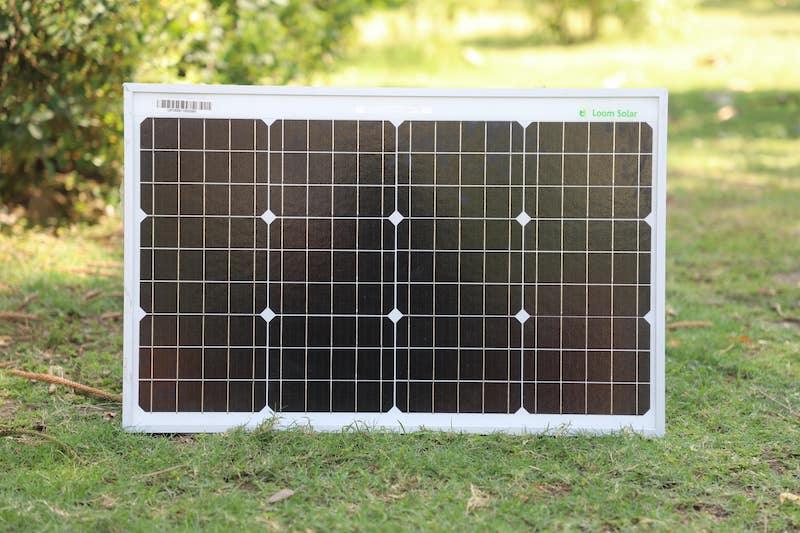
But it’s not the case that you necessarily need to buy a whole new camera just for the sake of having a solar panel, since, in many cases, leading brands already have solar panels that work across their product line. You can also DIY it.
DIY Solar Powered Security Camera?
You can check out some of our picks for great solar charging panels below, including a list of leading security camera manufacturers that sell their own. If your security camera features a micro USB or USB-C port, you’ll be able to find third party solar panels more easily.
As for battery powered devices, if you decide to go the DIY route with third party products you’ll need to know what the battery requirements of your security camera are. This way you can replace the battery with one that can be charged through a solar panel.
A word of warning: this is rather complicated, but it is doable if you have time on your hands.
In a nutshell, you’ll need to know the power rating (expressed in Watts) and voltage of the battery inside your camera so that you can buy a solar panel chargeable battery that meets the exact requirements of the camera’s native battery. If the battery is too strong or too weak, it may not work.
Unfortunately, it’s usually not so simple as buying a special kind of battery. You’ll need a solar panel, battery, controller, cables, connectors, enclosures, and DC power cables.
You might have also noticed that your security camera isn’t exactly designed to be ‘opened up’ for easy access to the battery and other internal components.
If that is the case, there’s also a very high chance that any warranties you have for the camera will be voided if you open it and replace the native battery. We’d recommend checking with the customer services provided by the manufacturer before you attempt anything.
6 Best Solar Panels for Your Security Camera
Even if you didn’t opt for a security camera pre-packaged with a solar panel, the good news is that the majority of leading security camera brands have introduced standalone solar panels that you can buy separately.
This means that if you already have a camera from a leading brand, there’s a high chance there’s an official solar panel to pair it with.
Here’s our favorites.
- Best solar panel for Google security cameras – Wasserstein Premium Solar Panel
- Best solar panel for Ring – Ring Solar Panel
- Best solar panel for Reolink – Reolink Solar Panel
- Best solar panel for Arlo – Arlo Solar Panel Charger
- Best solar panel for eufy – eufyCam Solar Panel Charger
- Best weatherproof solar panel for Micro USB and USB-C – ZUMIMALL Solar Panel – Great Option for DC 5V Cameras
Wasserstein Premium Solar Panel
Available at Wassertein. RRP $79.99.
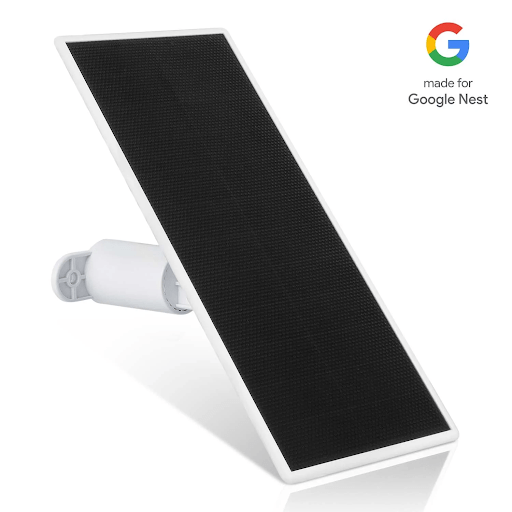
It’s got Google’s official stamp of approval on it, so expect it to be expensive. Though it certainly has a lot going for it. Its design is particularly slim and chic-looking, and anything but an eyesore.
This 3.5W solar panel was made specifically for the battery-model Google Nest Cam. It will charge the camera in a couple of hours and keep it powered round-the-clock, with the 360 degree rotatable mount allowing you to position it for maximum exposure.
There’s a cheaper version, but this one claims to be 30% more powerful. It’s hard not to recommend anything else for Google’s Nest Cam.
Ring Solar Panel
Available at Ring. RRP $39.99.
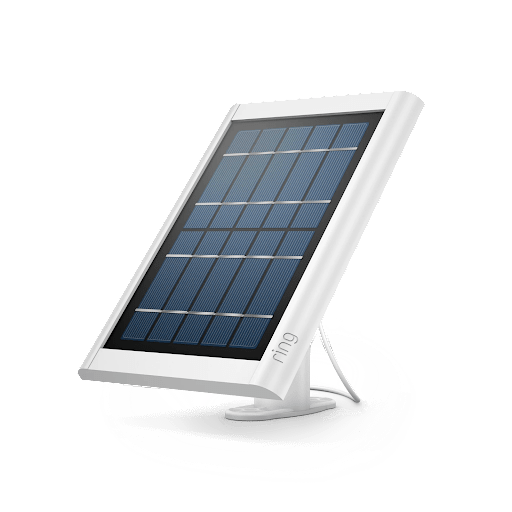
The solar panel available from Ring is designed to support its bestsellers: the battery-powered versions of the Stick Up Cam and Spotlight Cam, as well its Outdoor Alarm Siren.
At 2.2W, it’s a significantly lower output than other solar panels, but is designed specifically for enabling constant use of Ring products. The cable leaves a little to be desired, measuring in at 3.9 meters; fine for most uses, but for properties on the larger side, it might not be adequate.
Reolink Solar Panel
Available at Amazon. RRP $32.99.
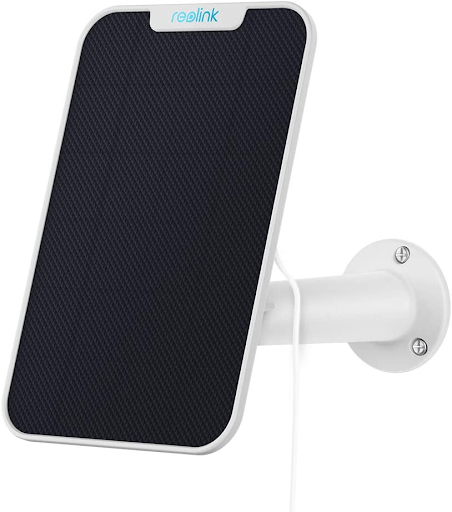
Reolink’s stand alone solar panel actually works with quite a significant portion of its line, including Argus 2, Argus Pro, Argus Eco, Argus PT, Go, and Go PT models. In other words, if you have a newer Reolink battery-powered camera, chances are this solar panel can power it.
The max voltage is 6V, which is somewhat higher than the average standard of 5V with micro USB cables, meaning you’ll get more power out of it. Particularly useful here is the option to add up to 2 extension cables, meaning you can have it positioned as far as 43 feet away from the camera itself—significantly further than other solar panels.
Arlo Solar Panel Charger
Available at Arlo. RRP $59.99, RRP $49.99 for Essential Version.

Presenting two different options, Arlo pretty much covers all its bases in terms of its pretty large line of cameras. The cheaper of the two is designed for its Essential line (the budget-friendly security cameras with more basic features), while those who have an Ultra, Pro 3, 4, or Go 2 camera will have to scrape together ten bucks more for the more expensive option.
While it’s a little annoying if you have a mixture of Essential and non-Essential cameras in your arsenal, both panels are otherwise identical, with generous 8 foot magnetic power cables and an easy install mount that can be adjusted for maximum sunshine.
eufyCam Solar Panel Charger
Available at Amazon (Europe). RRP £49.99.

Budget-friendly eufy also has an official solar panel, and its design is actually among the better ones. Not only is it chic and very petite, but its cylindrical mounting bracket can be twisted 360 degrees to obtain the best angle for sunshine.
Its solar cells are supposedly high-efficiency, and its output is 2.6W. A 13 foot cable is adequate, though again perhaps not sufficient for larger properties. The best part, of course, is that it is compatible with every single eufyCam.
ZUMIMALL Solar Panel – Great Option for DC 5V Cameras
Available at Amazon. RRP $27.99
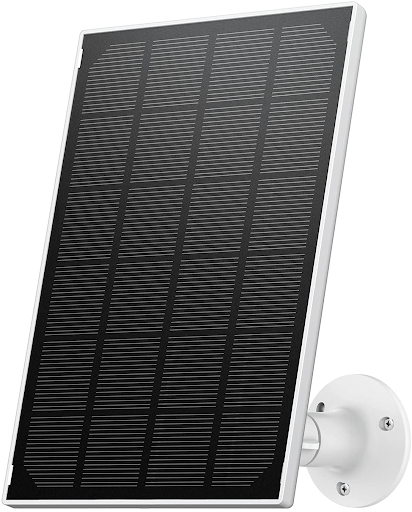
For a DC 5V rechargeable camera, Zuminall’s 5W solar panel is a super budget friendly option with easy mounting. Though its power cord is a measly 10 feet, it does connect via micro USB or USB-C, making it compatible with a significant number of security cameras.
But be aware, this explicitly excludes Arlo, Ring, Google Nest, and Kasa, so we’re afraid that opting for a cheaper version than the ‘official’ option probably won’t work.
How Do Solar Panels Work (In Case You Want to Know)?
Solar panels work by absorbing sunlight into PV (or photovoltaic) cells. These are the silicon cells you can see on the front of the panel. This generates an electrical DC current, which is then converted into AC (alternating current) electricity through an inverter contained within the panel. AC electricity is usable energy, which flows through to power the device the panel is connected to.
Conclusion
Solar Panels are a really useful addition to any outdoor security setup, allowing you to effectively leave your security camera for extended periods of time that is, assuming there’s sufficient sunlight. Not to mention, it’s far more efficient, so Mother Earth will thank you in the long run.
Should you just buy a security camera with a solar panel? Certainly, it’s a lot easier than modding a non-compatible camera. But as our list shows, quite a lot of the leading security camera brands now provide standalone solar panels that are exclusively compatible with their models.
As for opting for cheaper, third party panels, you’ll find that most won’t ‘technically’ be compatible with leading brands, since the goal is to have the consumer buy their own products. So though it means digging out an extra buck or two, we’d advise sticking with named brands if they have solar panels available. After all, this’ll still wind up cheaper than buying a whole new camera with a solar panel included.
Recommended reading: Types of Security Cameras: The Essential Guide
